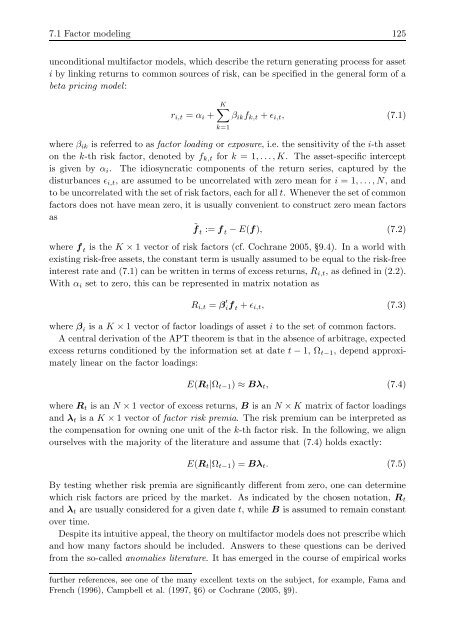Applications of state space models in finance
Applications of state space models in finance
Applications of state space models in finance
You also want an ePaper? Increase the reach of your titles
YUMPU automatically turns print PDFs into web optimized ePapers that Google loves.
7.1 Factor model<strong>in</strong>g 125<br />
unconditional multifactor <strong>models</strong>, which describe the return generat<strong>in</strong>g process for asset<br />
i by l<strong>in</strong>k<strong>in</strong>g returns to common sources <strong>of</strong> risk, can be specified <strong>in</strong> the general form <strong>of</strong> a<br />
beta pric<strong>in</strong>g model:<br />
ri,t = αi +<br />
K�<br />
k=1<br />
βikfk,t + ɛi,t, (7.1)<br />
where βik is referred to as factor load<strong>in</strong>g or exposure, i.e. the sensitivity <strong>of</strong> the i-th asset<br />
on the k-th risk factor, denoted by fk,t for k = 1, . . . , K. The asset-specific <strong>in</strong>tercept<br />
is given by αi. The idiosyncratic components <strong>of</strong> the return series, captured by the<br />
disturbances ɛi,t, are assumed to be uncorrelated with zero mean for i = 1, . . . , N, and<br />
to be uncorrelated with the set <strong>of</strong> risk factors, each for all t. Whenever the set <strong>of</strong> common<br />
factors does not have mean zero, it is usually convenient to construct zero mean factors<br />
as<br />
˜f t := f t − E(f), (7.2)<br />
where f t is the K × 1 vector <strong>of</strong> risk factors (cf. Cochrane 2005, ¢ 9.4). In a world with<br />
exist<strong>in</strong>g risk-free assets, the constant term is usually assumed to be equal to the risk-free<br />
<strong>in</strong>terest rate and (7.1) can be written <strong>in</strong> terms <strong>of</strong> excess returns, Ri,t, as def<strong>in</strong>ed <strong>in</strong> (2.2).<br />
With αi set to zero, this can be represented <strong>in</strong> matrix notation as<br />
Ri,t = β ′ if t + ɛi,t, (7.3)<br />
where β i is a K × 1 vector <strong>of</strong> factor load<strong>in</strong>gs <strong>of</strong> asset i to the set <strong>of</strong> common factors.<br />
A central derivation <strong>of</strong> the APT theorem is that <strong>in</strong> the absence <strong>of</strong> arbitrage, expected<br />
excess returns conditioned by the <strong>in</strong>formation set at date t − 1, Ωt−1, depend approximately<br />
l<strong>in</strong>ear on the factor load<strong>in</strong>gs:<br />
E(Rt|Ωt−1) ≈ Bλt, (7.4)<br />
where Rt is an N × 1 vector <strong>of</strong> excess returns, B is an N × K matrix <strong>of</strong> factor load<strong>in</strong>gs<br />
and λt is a K × 1 vector <strong>of</strong> factor risk premia. The risk premium can be <strong>in</strong>terpreted as<br />
the compensation for own<strong>in</strong>g one unit <strong>of</strong> the k-th factor risk. In the follow<strong>in</strong>g, we align<br />
ourselves with the majority <strong>of</strong> the literature and assume that (7.4) holds exactly:<br />
E(Rt|Ωt−1) = Bλt. (7.5)<br />
By test<strong>in</strong>g whether risk premia are significantly different from zero, one can determ<strong>in</strong>e<br />
which risk factors are priced by the market. As <strong>in</strong>dicated by the chosen notation, Rt<br />
and λt are usually considered for a given date t, while B is assumed to rema<strong>in</strong> constant<br />
over time.<br />
Despite its <strong>in</strong>tuitive appeal, the theory on multifactor <strong>models</strong> does not prescribe which<br />
and how many factors should be <strong>in</strong>cluded. Answers to these questions can be derived<br />
from the so-called anomalies literature. It has emerged <strong>in</strong> the course <strong>of</strong> empirical works<br />
further references, see one <strong>of</strong> the many excellent texts on the subject, for example, Fama and<br />
French (1996), Campbell et al. (1997, 6) or Cochrane (2005, 9).

















